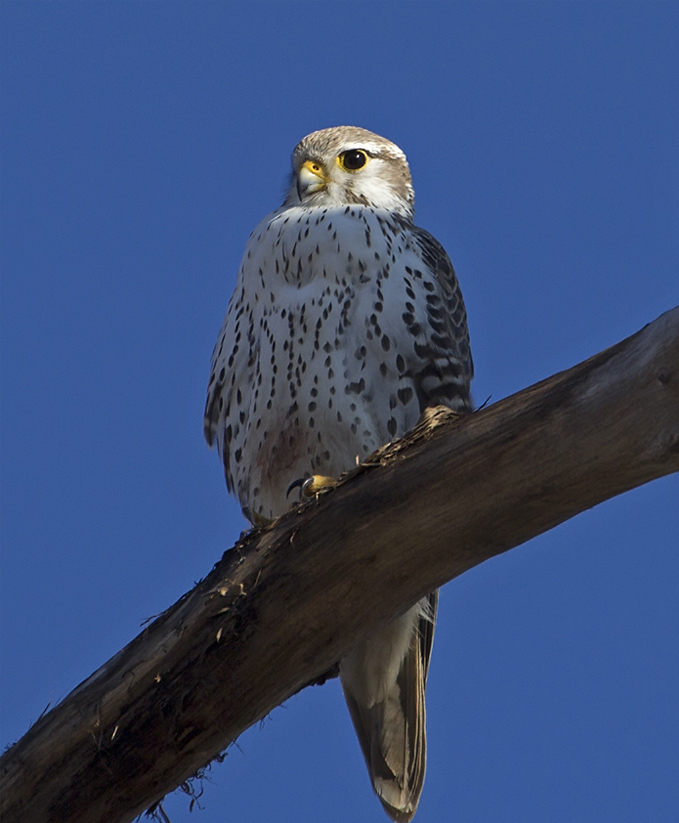
by John Shackford
The main winter range of the Prairie Falcon (Falco mexicanos) in Oklahoma covers the western 1/3rd of the state; sometimes one makes it to central Oklahoma. It is one of the bird species that is very hit and miss on our Christmas Bird Count (CBC), one being sighted about every 2-3 years.
In this year’s CBC it was a hit! It was Jimmy Woodard’s party that found one. They found the bird west of Wiley Post Airport. It is always a good feeling to find one because they are not particularly easy to find—they often sit low, fence-post low or even on the ground and they do not spend as much time in the air soaring as the Red-tailed Hawk. I ascribe its finding on our bird count to excellent birders, hard work and good luck.
The Prairie Falcon has a dark brown back and a whitish breast with dark streaks on the breast, particularly on the sides of the breast. The face has considerable whitish with a prominent dark brown vertical slash in the middle. The best field mark of the bird can only be seen when it is flying—black “armpits” under the wings. But on some birds, probably young of the year, this armpit black is not well pronounced, so you have to be a little careful. The Prairie Falcon is basically a lighter version of the Peregrine Falcon, but the Peregrine does not have the black armpits.
I was once lucky to witness a very interesting predatory situation in a prairie dog town. It was during the falcon’s non-breeding season and I was near Knowles, Beaver County, in the Oklahoma Panhandle. I was sitting in my car watching some prairie dogs in a small dogtown. Quite unexpectedly, a coyote launched up over a bank—where he had been out of my sight—into the dogtown in an effort to catch a prairie dog no doubt. And immediately after the coyote sprang, a Prairie Falcon swooped across the dogtown. The Prairie Falcon apparently wanted to catch a prairie dog too. As I pieced it all together, the coyote was waiting for the perfect moment to attack the town as was the Prairie Falcon. But each predator saw the other and possibly me and somebody blinked. I do not know if it was the Prairie Falcon or the coyote. But the perfect moment never quite arrived for either predator. The prairie dogs won and I, as an observer, won, getting to see a fairly complicated moment of drama in a dogtown.
Prairie Falcons are rare nesters in the Black Mesa area of Cimarron County. They usually nest on a shelf, hole or crevice on the face of a cliff. The species usually lays 3-5 eggs. According to the Oklahoma Breeding Bird Atlas (Reinking, D. L., editor. 2004), the eggs are “white or creamy with variable dark brown spots, splotches, or bands.” They vary quite a bit in color and when egg collecting was popular (and legal), Prairie Falcon eggs were highly prized by oologists. An interesting thing about the color of the eggs is that females lay eggs very close to the same egg pattern year after year, whatever that particular pattern for that female may be. If egg color and pattern change much in a particular area from the previous year it means that a new female has replaced the previous female.
During the spring and summer of 1986, while working with the Sutton Avian Research Center, I studied 5 rare nesting bird species in Cimarron County and one of these was the Prairie Falcon. We found only 2 nests of the falcon that year, although another study done in 1995 found 7 nests, presumably in the same area. In any case they are rare nesters in Oklahoma. In the 1986 study several Sutton Center employees helped me look for nests and one of them, a falconer, helped find 1 of the 2 nests we found that year.
The female birds sit very tightly on a nest with eggs and this falconer’s method of finding out if a hole in the cliff contained a nest was to fire a rifle to one side of a possible nest hole and see if anything flew out. Both the sound of the gun and the sound of a bullet hitting near the nest had potential to scare any nesting bird from the nest, and one nest was found this way. Another tip to finding nests is to look for holes in cliffs that contain whitewash downward on the cliff from the opening.
